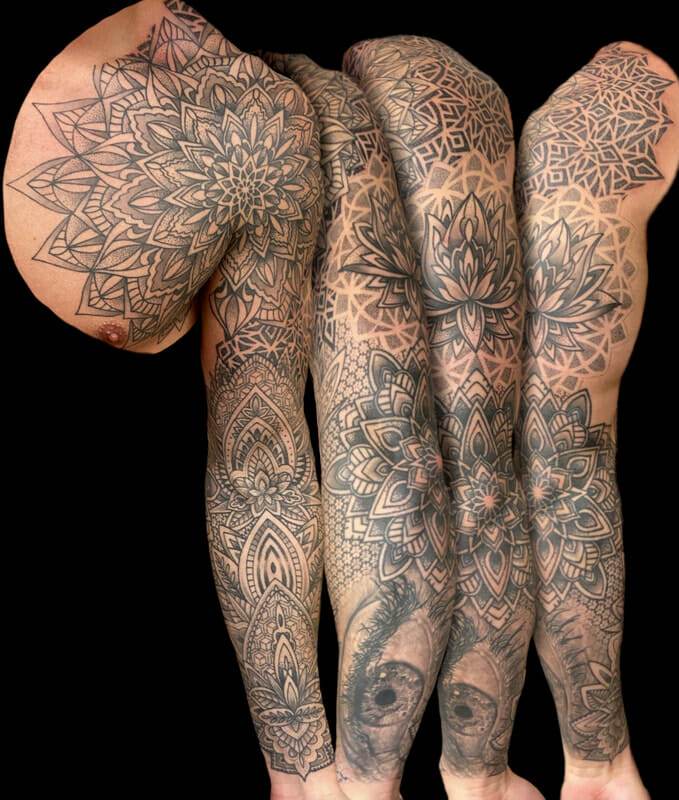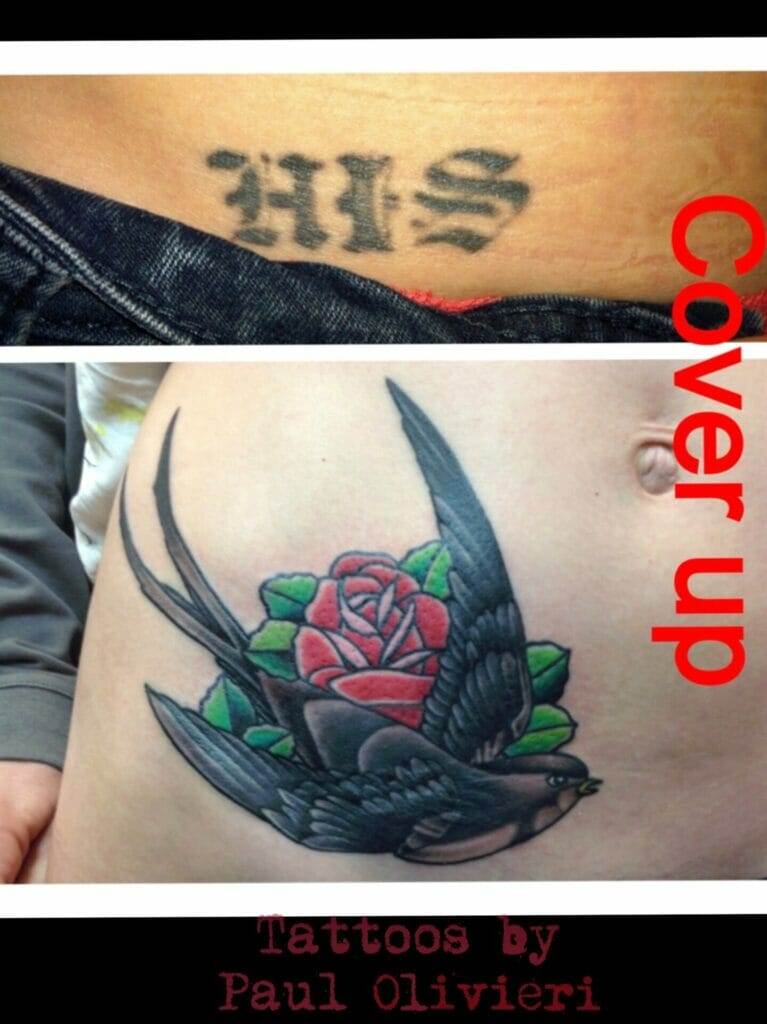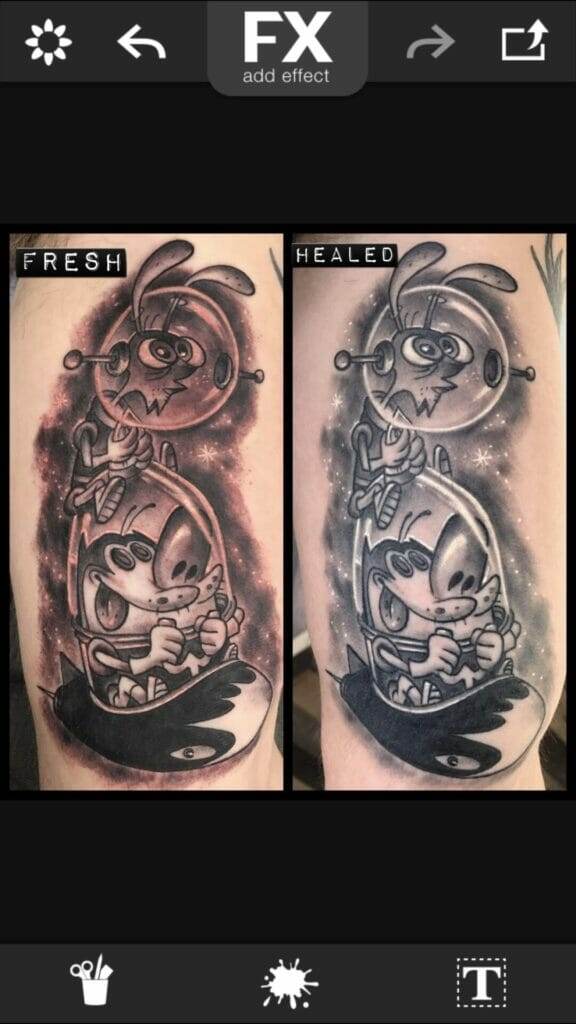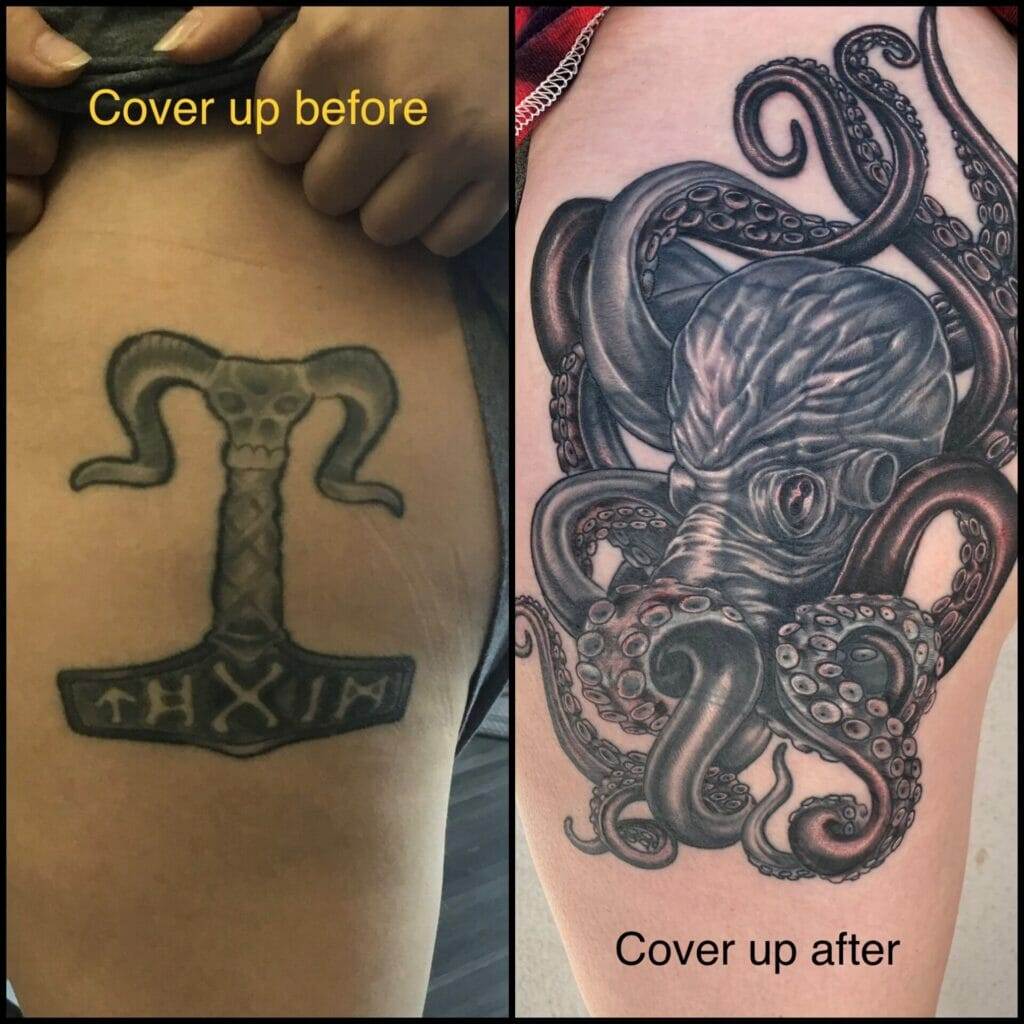cover-up tattoos have become increasingly popular in recent years as more and more people seek to correct or conceal tattoos they regret. Whether it’s a poorly executed design, a reminder of a past relationship, or simply a change in personal taste, cover-up tattoos offer a solution for those looking to move on from their tattoo regrets. In this blog post, we will explore the rise of cover-up tattoos, the psychology behind tattoo regret, the options for tattoo correction, finding the right tattoo artist, the design process, what to expect during the cover-up process, managing pain and aftercare, coping with the emotional journey, and the future of cover-up tattoos.
The Rise of Cover-Up Tattoos: A Growing Trend in the Tattoo Industry
Cover-up tattoos are designs that are specifically created to conceal or modify an existing tattoo. They have gained popularity in recent years due to advancements in tattooing techniques and the increasing number of people seeking to correct or change their tattoos. Cover-up tattoos offer a way for individuals to transform their unwanted tattoos into something they can be proud of.
There are various reasons why people choose to get cover-up tattoos. One common reason is that they have outgrown or changed their personal style and no longer resonate with their existing tattoo. Another reason is that they may have gotten a tattoo that was poorly executed or did not turn out as expected. Additionally, some people may want to cover up tattoos that remind them of a past relationship or a period in their life that they would rather forget.
Popular cover-up tattoo designs include floral patterns, geometric shapes, animals, and abstract designs. These designs are often chosen because they can effectively camouflage the existing tattoo while creating a visually appealing new design.
The Psychology of Tattoo Regret: Understanding the Motivations Behind Cover-Ups
Tattoo regret is a common phenomenon that can occur for a variety of reasons. Some people may regret their tattoos because they no longer resonate with the design or the meaning behind it. Others may regret their tattoos due to societal or professional pressures, as visible tattoos can sometimes be stigmatized in certain environments.
Cover-up tattoos can help individuals move on from their tattoo regrets by providing a fresh start and a chance to create a new design that better aligns with their current preferences and values. The process of getting a cover-up tattoo can be empowering and cathartic, allowing individuals to reclaim control over their bodies and their self-expression.
Cover-Up vs. Removal: Weighing Your Options for Tattoo Correction
When it comes to tattoo correction, individuals have two main options: cover-up tattoos or tattoo removal. Each option has its pros and cons, and the choice ultimately depends on the individual’s specific circumstances and preferences.
Cover-up tattoos offer a more immediate solution for those looking to conceal or modify their existing tattoos. They can be done in a single session and allow individuals to transform their unwanted tattoos into something they can be proud of. However, cover-up tattoos may not be suitable for all types of tattoos, especially those with dark or dense ink.
Tattoo removal, on the other hand, involves the use of laser technology to break down the ink particles in the skin. This process requires multiple sessions and can be more expensive and time-consuming than getting a cover-up tattoo. However, tattoo removal offers a more complete solution for those looking to completely remove their unwanted tattoos.
When deciding between cover-up tattoos and tattoo removal, it is important to consider factors such as the size and location of the tattoo, the colors used, the individual’s pain tolerance, and their desired outcome. Consulting with a professional tattoo artist or a dermatologist specializing in tattoo removal can help individuals make an informed decision.
The Art of Design: Creating Custom Cover-Up Tattoos that Work

Designing a cover-up tattoo requires careful consideration and planning to ensure that the new design effectively conceals or modifies the existing tattoo. The process typically involves working closely with a tattoo artist to create a custom design that takes into account the size, shape, and colors of the existing tattoo.
One common technique used in cover-up tattoos is incorporating elements of the existing tattoo into the new design. This can be done by using the lines or shapes of the existing tattoo as a foundation for the new design or by incorporating elements of the existing tattoo into the background or surrounding areas.
Another technique used in cover-up tattoos is using strategic shading and color placement to effectively conceal the existing tattoo. By using darker colors or shading techniques, tattoo artists can create depth and dimension that help to camouflage the unwanted tattoo.
Successful cover-up tattoo designs often require multiple sessions to complete, as the process of layering and blending colors takes time. It is important for individuals to be patient and trust the process, as the end result will be worth it.
The Cover-Up Process: What to Expect During Your Tattoo Correction Journey
The cover-up tattoo process typically involves several steps, from the initial consultation to the final touch-ups. Here is a step-by-step breakdown of what to expect during your tattoo correction journey:
1. Consultation: During the initial consultation, you will meet with your tattoo artist to discuss your desired outcome and any concerns or limitations related to your existing tattoo. The artist will assess the size, shape, and colors of the existing tattoo and provide recommendations for the cover-up design.
2. Design: Once you have agreed on a design with your tattoo artist, they will create a custom design that takes into account the size, shape, and colors of the existing tattoo. This design may go through several iterations before it is finalized.
3. Tattooing: The actual tattooing process will take place over multiple sessions, depending on the complexity of the design and the size of the existing tattoo. During each session, your tattoo artist will carefully layer and blend colors to effectively conceal or modify the existing tattoo.
4. Healing: After each session, it is important to follow proper aftercare instructions to ensure optimal healing and minimize the risk of infection or complications. This may include keeping the tattoo clean and moisturized, avoiding direct sunlight or swimming pools, and refraining from picking or scratching at the tattoo.
5. Touch-ups: Once the initial healing process is complete, you may need to schedule a touch-up session to make any necessary adjustments or refinements to the design. This is a normal part of the cover-up process and ensures that the final result is as desired.
The Pain Factor: Navigating the Discomfort of Cover-Up Tattoos
It is important to note that cover-up tattoos, like any other tattoo, can be painful. The level of pain experienced during the tattooing process can vary depending on factors such as the individual’s pain tolerance, the location of the tattoo, and the size and complexity of the design.
To manage pain during the tattooing process, there are several strategies that individuals can employ. One common technique is taking over-the-counter pain medication, such as ibuprofen or acetaminophen, before the tattoo appointment. This can help to reduce pain and discomfort during the tattooing process.
Another technique is using numbing creams or sprays that can be applied to the skin prior to the tattooing process. These products work by temporarily numbing the skin and reducing pain sensations. It is important to follow the instructions provided by the manufacturer and consult with your tattoo artist before using any numbing products.
Additionally, some individuals find that deep breathing exercises or listening to music can help distract from the pain and promote relaxation during the tattooing process. Communicating with your tattoo artist and letting them know if you are experiencing discomfort is also important, as they can make adjustments to ensure your comfort.
The Healing Process: Tips for Proper Aftercare and Optimal Results
Proper aftercare is crucial for ensuring optimal healing and achieving the best results with your cover-up tattoo. Here are some tips to follow during the healing process:
1. Keep it clean: Gently wash your tattoo with mild soap and warm water, using your clean hands or a soft cloth. Avoid scrubbing or rubbing the tattoo, as this can cause irritation or damage to the healing skin.
2. Moisturize regularly: Apply a thin layer of fragrance-free moisturizer or tattoo aftercare ointment to keep the tattoo hydrated and prevent dryness or cracking. Be sure to follow the instructions provided by your tattoo artist or dermatologist.
3. Avoid direct sunlight: Protect your tattoo from direct sunlight, as UV rays can fade the colors and cause the tattoo to lose its vibrancy. If you need to be in the sun, apply a broad-spectrum sunscreen with a high SPF to the tattooed area.
4. Avoid swimming pools and hot tubs: Chlorine and other chemicals in swimming pools and hot tubs can irritate the healing skin and increase the risk of infection. It is best to avoid these activities until your tattoo is fully healed.
5. Avoid picking or scratching: It is important to resist the urge to pick or scratch at your tattoo, as this can disrupt the healing process and increase the risk of infection. If you experience itching, gently pat or tap the tattooed area instead.
By following these aftercare tips and taking proper care of your cover-up tattoo, you can ensure optimal healing and achieve the best possible results.
The Emotional Journey: Coping with the Emotional Toll of Tattoo Correction
Tattoo regret can have a significant emotional impact on individuals, as it can serve as a constant reminder of past mistakes or experiences they would rather forget. The process of getting a cover-up tattoo can be emotionally challenging, as it requires individuals to confront their regrets and make peace with their past choices.
It is important for individuals to acknowledge and validate their emotions throughout the tattoo correction journey. This may involve seeking support from friends, family members, or mental health professionals who can provide a safe space for individuals to express their feelings and work through their emotions.
Engaging in self-care activities such as exercise, meditation, journaling, or engaging in hobbies can also help individuals cope with the emotional toll of tattoo correction. These activities can provide a sense of control, relaxation, and distraction from negative thoughts or emotions.
It is also important to remember that getting a cover-up tattoo is a proactive step towards moving on and finding closure. By transforming their unwanted tattoos into something they can be proud of, individuals can reclaim their bodies and their self-expression, ultimately finding peace and acceptance.
The Redemption Factor: How Cover-Up Tattoos Can Help You Move On and Find Closure
Cover-up tattoos offer a sense of redemption for individuals with tattoo regret. By transforming their unwanted tattoos into something they can be proud of, individuals can move on from their regrets and find closure.
For some, getting a cover-up tattoo can be a symbolic act of letting go and embracing change. It can serve as a visual reminder of their personal growth and transformation, allowing them to leave the past behind and move forward with confidence.
Cover-up tattoos can also provide closure for individuals who have experienced trauma or difficult life experiences associated with their existing tattoos. By concealing or modifying these tattoos, individuals can reclaim control over their bodies and their narratives, empowering them to rewrite their stories and create a new chapter in their lives.

The Future of Cover-Up Tattoos: Innovations and Advancements in Tattoo Correction Technology
The field of tattoo correction is constantly evolving, with new technologies and techniques being developed to improve the cover-up process. One such advancement is the use of laser technology to lighten or remove unwanted tattoos before getting a cover-up tattoo.
Laser tattoo removal works by targeting the ink particles in the skin with high-intensity laser beams. These beams break down the ink particles into smaller fragments, which are then naturally eliminated by the body’s immune system. This process can significantly lighten or remove unwanted tattoos, making it easier for tattoo artists to create effective cover-up designs.
Another innovation in tattoo correction technology is the use of specialized pigments that are designed to effectively cover up dark or dense tattoos. These pigments are formulated to provide maximum coverage while maintaining vibrant colors and longevity.
As technology continues to advance, it is likely that we will see further improvements in tattoo correction techniques and technologies. This will provide individuals with even more options for correcting or concealing their unwanted tattoos, ultimately leading to better outcomes and increased satisfaction.
Cover-up tattoos have become a popular solution for individuals looking to correct or conceal their tattoo regrets. They offer a way for individuals to transform their unwanted tattoos into something they can be proud of, providing closure and a fresh start. By understanding the rise of cover-up tattoos, the psychology behind tattoo regret, the options for tattoo correction, finding the right tattoo artist, the design process, what to expect during the cover-up process, managing pain and aftercare, coping with the emotional journey, and the future of cover-up tattoos, individuals can make informed decisions and embark on their tattoo correction journey with confidence.



